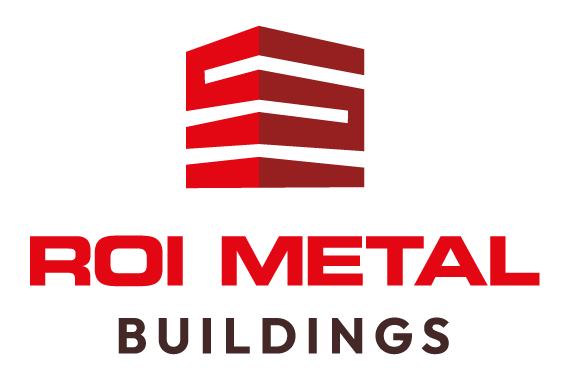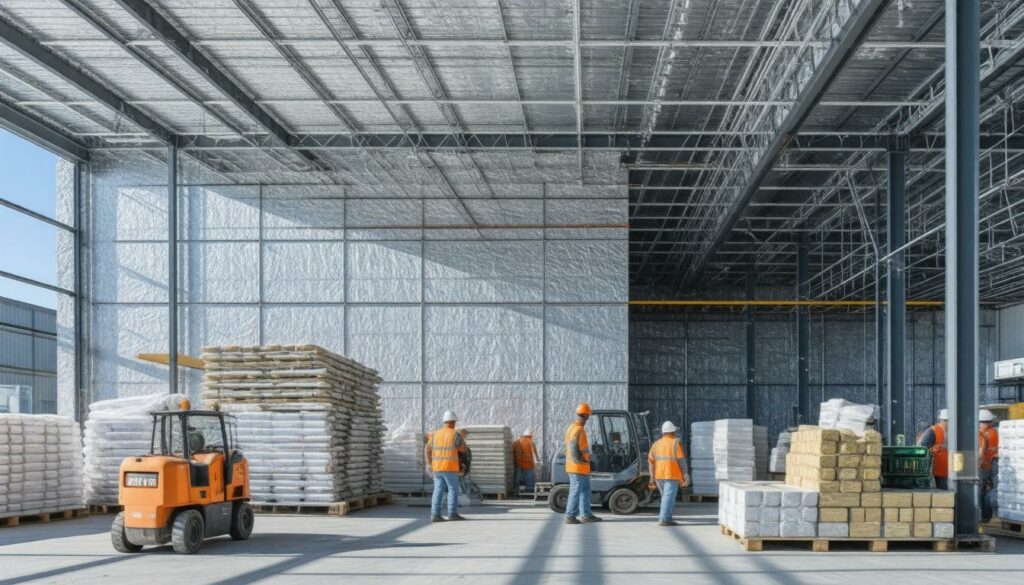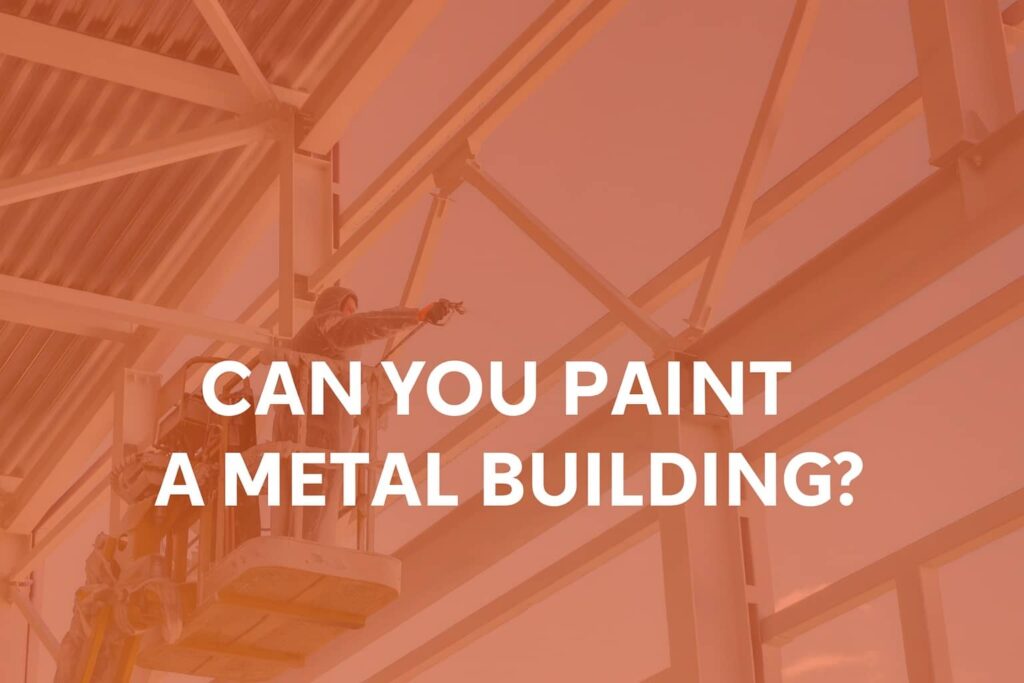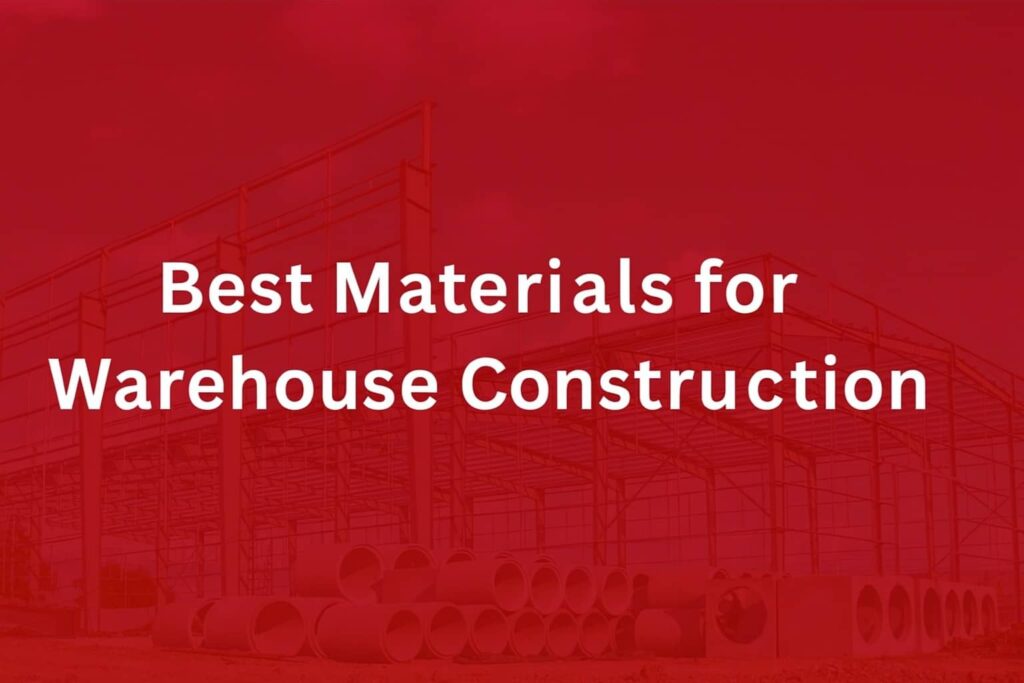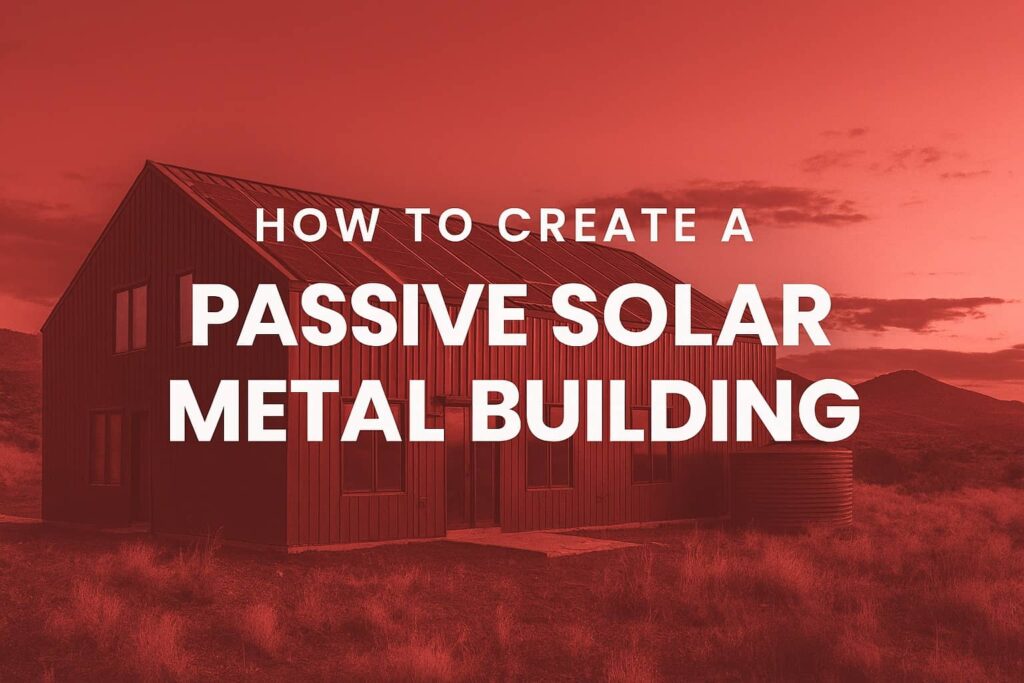When it comes to metal buildings, insulation is often an afterthought—but it shouldn’t be. Proper insulation not only keeps your workspace comfortable, but it also can significantly reduce energy costs and enhance the overall durability of your structure. With so many insulation options for commercial metal buildings, it’s important to understand what each option offers before making a decision. This guide breaks down some top insulation types for commercial metal buildings, highlighting their benefits, effectiveness, and installation tips that can help you get the most out of your investment. Let’s dive in and explore the options that will keep your building cozy, efficient, and cost-effective for years to come!
Yesterday we published an article about Commercial Metal Building Permits and Regulations and the feedback has been great! We appreciate the support. This was the kickoff article of a dedicated mini-series diving into commercial metal buildings and commercial metal building sales. Join us in the coming few days and/or weeks while we answer your questions about commercial metal buildings. Today we are going to dive deep on insulation options for commercial metal buildings.
The best insulation options for commercial metal buildings include spray foam, rigid board, batt and blanket, loose-fill, and foil bubble insulation. Each option offers different R-values and advantages; for example, spray foam provides superior thermal resistance and air sealing properties, while rigid board is ideal for durability against natural elements, making it essential to choose based on your specific needs and local building codes.
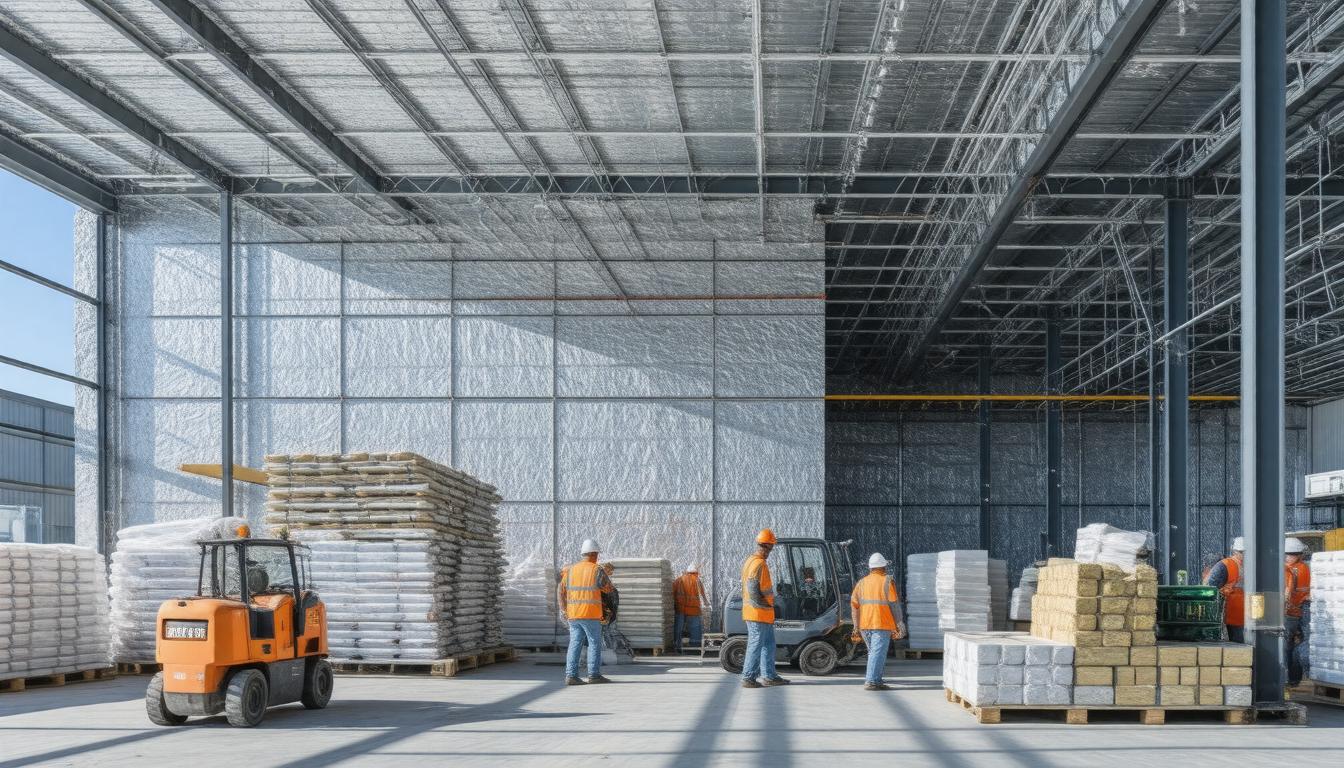
Top Insulation Choices for Metal Buildings
When it comes to insulating commercial metal buildings, choosing the right material can make all the difference in comfort, energy efficiency, and structural integrity. Among the most popular options available are:
- Spray foam insulation
- Rigid board insulation
- Batt and blanket insulation
- Loose-fill insulation
- Foil bubble insulation
Each has its unique benefits and ideal applications.
Spray Foam Insulation
Spray foam insulation remains a frontrunner due to its remarkable properties. Comprising polyurethane, this type of insulation expands significantly—30 to 60 times its liquid volume—effectively filling gaps and forming a seamless barrier.
What does this mean for your building? Well, it boasts an impressive R-value between R-3.4 to R-6.7 per inch, which directly translates to superior temperature regulation inside the structure. Notably, when using closed-cell spray foam, you gain dual benefits: it acts as both a vapor barrier and an air barrier if applied at a thickness of around 50 mm. This feature is crucial because it prevents moisture buildup, safeguarding your building from potential damage caused by condensation.
Following closely on the heels of spray foam is another strong contender: rigid board insulation.
Rigid Board Insulation
Rigid board insulation is composed of sturdy materials like polystyrene, polyurethane, or polyisocyanurate. Its design offers durability coupled with excellent moisture resistance—two attributes that are pivotal in many commercial settings.
The R-value typically ranges from R-4.0 to R-8.0 per inch, making it one of the higher-performing options available. This type of insulation shines particularly in flat roofs and foundations where additional protection from environmental elements is necessary; it ensures consistent thermal performance while being robust against moisture intrusion.
As we explore more options, let’s consider a flexible choice: batt and blanket insulation.
Batt and Blanket Insulation
Batt and blanket insulation is primarily made from fiberglass and fits neatly between joists and beams in your metal building’s structure. While its R-value ranges from R-2.9 to R-3.8 per inch may seem lower than other options, this type can be quite effective when installed correctly in areas where flexibility is needed.
It’s commonly used in wall cavities and ceilings, offering ease of installation without compromising on energy efficiency.
In scenarios where irregular spaces present challenges, loose-fill insulation becomes a fantastic alternative.
Loose-fill Insulation
This option often comprises cellulose or fiberglass and excels at filling nooks and crannies that batt or blanket insulation might not reach effectively.
With an R-value ranging from R-2.2 to R-3.8 per inch, loose-fill insulation provides decent thermal performance while accommodating obstructions easily—ideal for attics or walls that cannot fit standard batts.
Finally, let’s shine a light on foil bubble insulation.
Foil Bubble Insulation
Lightweight and incredibly easy to install, foil bubble insulation reflects radiant heat away from your building’s interior while minimizing downward heat flow.
Although its lower R-value of R-1.0 to R-1.3 per inch may raise eyebrows, its ability to reflect up to 97% of radiant heat makes it an appealing option when seeking efficient temperature management in certain climates. Many users find great satisfaction in integrating this type of insulation as part of a multipronged approach alongside other insulative strategies.
Understanding these various insulation choices allows you to pick the right product that not only meets your needs but also enhances energy efficiency within your metal building for years to come.
With these options laid out before you, let’s take a closer look at one popular choice that stands out for its accessibility and effectiveness in numerous applications.
Fiberglass Batts and Blankets Explained
Known for their affordability and efficiency, fiberglass batt insulation is a favored choice for many commercial applications. Made from fine glass fibers, this type of insulation is engineered to fit snugly between wall studs, floor joists, and ceiling rafters. The application is straightforward: sold in pre-cut panels or rolls, fiberglass batts are easy to install, making them suitable for both professionals and DIY enthusiasts alike.
When installing, it helps to stop and ensure the insulation fits tightly; gaps can severely compromise its effectiveness.
One interesting feature is the option to choose batt insulation with a kraft paper or foil backing. This not only helps secure the insulation in place but also acts as a vapor barrier, enhancing overall energy efficiency. In this manner, it plays a dual role—insulating against heat loss while also preventing moisture build-up that could lead to damage over time. Research indicates that when installed properly, fiberglass batts can cut heating costs by up to 25%, which is significant for business owners looking to manage expenses without sacrificing comfort.
Considering all these advantages brings us to another important aspect of fiberglass batts—soundproofing.
Soundproofing Benefits
Fiberglass has inherent sound-absorbing properties that contribute significantly to reducing noise transmission in busy environments such as commercial complexes. This is particularly valuable for offices or workspaces where focus and concentration are essential. The soundproofing capabilities of fiberglass are quantified using the Sound Transmission Class (STC) rating; the higher the STC rating, the better the materials can block sound.
For instance, fiberglass batts typically achieve an STC rating that reflects their high efficiency in controlling noise levels.
Therefore, opting for fiberglass isn’t just about thermal insulation; it’s also about creating a more pleasant and productive acoustic environment within your commercial metal building. The combination of temperature regulation and noise reduction makes fiberglass batts an all-around solution for many businesses looking to maximize comfort while maintaining cost-effectiveness.
As you explore different insulation choices, consider how these features align with your specific needs and local climate regulations while also thinking about how reflective coatings could further elevate performance.
Benefits of Reflective Foil Coatings

Reflective foil coatings might not be the first option that comes to mind, but they offer unique benefits that make them a commendable choice. Made from layers of polyethylene or foil, these coatings are excellent at blocking radiant heat transfer, thus maintaining indoor temperatures more effectively. As sunlight hits a building’s exterior, much of that energy becomes trapped inside without effective insulation. However, reflective foil works wonders by reflecting radiant heat back outside during peak sun hours, vastly improving comfort levels inside.
Energy Efficiency
One of the most compelling reasons to consider reflective foil is its impact on energy efficiency. Using these coatings can reduce cooling costs by up to 10% in hot climates. The following table shows the potential savings based on different climate zones:
| Climate Zone | Potential Savings with Reflective Foil |
|---|---|
| Hot & Humid | 8-10% |
| Temperate | 5-7% |
| Cold | 3-5% |
The statistics clearly indicate how significant these savings can be over time; it’s about reducing wasted energy and maximizing your investments in your building.
Besides energy savings, let’s consider installation ease.
Ease of Installation
Installing reflective foil coatings is surprisingly simple—comparable to laying aluminum foil on a baking sheet. They are designed for simplicity and efficiency, making them ideal for both new constructions and retrofit projects. You won’t find complex tools or specialized skills necessary; all that’s needed is basic equipment like scissors and adhesive tape.
This ease means you can apply them to roofs, walls, and even floors without disrupting your business activities. Since no special training is required, many owners choose to take on the project themselves. By doing so, you save on labor costs while contributing positively to your building’s energy efficiency.
Having reviewed their benefits and installation ease, it’s important to recognize how reflective foils can also enhance indoor air quality and overall comfort.
Key Factors in Selecting Insulation

When it comes to selecting insulation, the crucial aspect to consider is the R-value, which measures an insulation material’s resistance to heat flow. A higher R-value indicates better insulating effectiveness and is vital to select materials that align with local climate conditions. For instance, those in colder regions may require insulation with a higher R-value to effectively trap heat during frigid winters. Consult local building codes, as they often specify minimum R-values tailored to specific regions. This helps ensure that your building remains comfortable while keeping energy costs manageable.
Once you’ve evaluated the R-value, the next factor to focus on is moisture resistance.
Moisture Resistance
It’s essential to choose insulation materials that can withstand humidity and condensation, particularly in areas prone to dampness. Materials like closed-cell spray foam or rigid board insulation are excellent choices because they resist moisture and help prevent mold growth. While traditional fiberglass insulation can be susceptible to moisture accumulation, closed-cell spray foam creates a robust barrier that shields against humid conditions, maintaining both air quality and structural health over time. This proactive approach ensures that your metal building’s atmosphere remains dry and comfortable without incurring the additional expenses associated with mold remediation.
After addressing moisture concerns, durability is another critical component of your insulation choice.
Durability and Longevity
Durability plays a significant role in the longevity of your insulation investment. Opting for materials that can withstand external pressures—like impacts from weather or human activity—is essential. For example, rigid board insulation provides high thermal resistance while maintaining its shape and integrity over prolonged periods. This quality means fewer repairs and replacements down the line—saving both time and money while enhancing occupant comfort. Moreover, selecting durable insulation contributes towards a more resilient building overall; one that can handle various environmental stresses while providing consistent performance year after year.
Lastly, it’s vital to consider installation ease and maintenance requirements when choosing insulation type.
Ease of Installation and Maintenance
Choosing an insulation material should also take the installation process into account. Some options, like fiberglass batts, can be suitable for DIY projects due to their relatively straightforward installation features. However, materials such as spray foam typically require professional installation due to specialized equipment and techniques involved. Therefore, weigh the pros and cons based on your budget and expertise level—while a more complex installation may yield superior results initially, it’s crucial that you have the resources available for proper installation and potential future maintenance.
Understanding these key factors creates a foundation for making informed decisions when assessing options for effective thermal management and soundproofing within your structure.
Evaluating Thermal and Acoustic Performance
The effectiveness of insulation materials is often quantified by their ability to resist heat flow—this is precisely what we refer to when discussing thermal performance. High R-value insulation materials, such as spray foam, offer considerable benefits. They can maintain comfortable indoor temperatures while reducing energy consumption. As a result, during peak winter or summer months, your heating and cooling systems won’t have to work as hard, which leads to lower utility bills and a smaller carbon footprint. This “little” change can make a big difference.
Alongside thermal properties, we must consider the acoustic performance of insulation materials. Acoustic insulation reduces sound transmission—something invaluable in busy commercial settings where loud machinery or human activity can disrupt operations or employee comfort. For instance, traditional fiberglass batt insulation boasts an STC (Sound Transmission Class) rating of 39. This rating makes it ideal for environments that might experience considerable noise levels, ensuring conversations remain private and focus isn’t compromised by outside distractions.
Understanding how these two aspects interact can provide an even clearer view of overall energy efficiency.
When insulation excels in both thermal and acoustic performance, the result is a comfortable yet productive environment. By effectively regulating temperature and dampening noise, these insulated spaces enhance overall employee satisfaction. Happy employees are more productive; it’s a simple truth many companies overlook. This synergy between effective insulation and operational efficiency cannot be overstated.
Additionally, integrating advanced materials such as spray foam or aerogels not only improves thermal resistance but also promotes better acoustic control. These innovative options typically seal gaps and create airtight barriers that prevent unwanted air intrusion—a common flaw in older insulation types. Consequently, they keep the space cozy during colder months while minimizing echoes or unwanted sound transferring between rooms.
Thus, when selecting insulation for your commercial metal building, pay particular attention to these performance metrics.
Investing in quality insulation with excellent thermal and acoustic properties leads to significant long-term benefits. It fosters an energy-efficient environment while keeping workspaces pleasant and quiet, ultimately improving productivity outcomes. Remember that opting for appropriate insulation solutions doesn’t just enhance your building’s performance; it creates a safe haven for all activities held within those sturdy metal walls.
With this understanding of insulation’s crucial role, exploring further strategies for optimizing energy use will reveal even greater potential for cost savings and sustainability.
Maximizing Energy Efficiency and Savings
Energy efficiency goes beyond simply keeping more money in your pocket; it also contributes to a healthier planet. Proper insulation plays an instrumental role in ensuring that your metal building remains energy-efficient, creating a more comfortable environment while minimizing waste. The right insulation acts as a shield, regulating temperature and drastically reducing the workload on your heating, ventilation, and air conditioning (HVAC) systems. This balancing act not only leads to conscious consumption but enhances the longevity of your equipment, saving you dollars on maintenance costs over time.
One major benefit of optimal insulation is its ability to maintain a steady internal climate. By properly insulating your metal building, you’re effectively reducing the load on your HVAC systems, which translates into lower energy consumption overall. As energy usage decreases, your emissions will also follow suit, reducing your footprint and contributing to overall sustainability efforts. It turns into a win-win situation where you get both comfort and cost savings.
According to the U.S. Department of Energy, when buildings are adequately insulated, they can reduce heating and cooling costs by 30%. That’s a remarkable statistic that showcases just how crucial insulation can be for energy efficiency—and that number isn’t something to take lightly!
To further emphasize this point, let’s consider various insulation options available for commercial metal buildings. Each type provides unique benefits that cater to different environments and conditions. For instance, spray foam insulation stands out for its exceptional thermal resistance; it expands to form an airtight seal while serving as a moisture barrier—both indispensable when combating the metal building’s inherent temperature fluctuations.
On the other side of the spectrum lies fiberglass insulation, which is budget-friendly and accessible for DIYers. While it does have moisture sensitivity limitations, it serves the purpose well in environments where humidity isn’t excessive. Your budget and climate should drive these choices—understanding how each type performs under varying conditions enhances your chances of selecting an effective material for your specific requirements.
With these considerations in mind, exploring advanced installation methods becomes essential for achieving those energy-saving goals and maintaining comfort throughout your building.
Installation Best Practices and Tips to Follow
The proper installation of insulation is not merely about sticking it in place; it’s an art that directly impacts the efficiency and comfort of your building. Before you even begin, preparation plays a vital role. Always start by ensuring that your work area is free from debris, dust, and any moisture, as this will help adhesion and prevent problems during installation.
It’s essential to gather all necessary materials upfront—this includes insulation panels, cutting tools, sealing materials, and protective gear.
Protective measures, such as gloves and masks, are critical because they prevent potential skin irritation or inhalation of small fibers while working with various insulation types.
Next comes the measurement phase. Accurate measurements are key—after all, insulation that doesn’t fit well can lead to energy loss over time. Take the width and height of the areas needing insulation carefully; if you’re working with multiple sections or different shapes, consider creating a simple sketch to avoid confusion later on.
Once you have your measurements down, it’s time to cut and fit the insulation. Use a sharp utility knife for clean cuts. Aim for snug fits—this means fitting your insulation tightly against walls or ceilings without compressing it excessively, as compressing can reduce its insulating properties. Remember that insulation works best when it fills every nook and cranny!
Sealing is another crucial step in the process. Once installed, gaps can form due to natural settling or imperfect fits. Failing to seal these gaps allows air – both hot and cold – to move through freely, negating your hard work. Use caulk or spray foam to seal any noticeable openings around edges where different insulation types meet or where vents are located. This creates continuous thermal barriers that protect against drafts.
One installer shared their experience: “Using spray foam around edges reduced our energy bills significantly by eliminating drafts.” This highlights how important sealing adequately is; a little attention here pays off on your energy bill!
Following these guidelines ensures that your insulation installation process maximizes effectiveness and long-term savings. By preparing correctly, measuring accurately, cutting precisely, and sealing thoroughly, you’ll create a foundation not just for energy efficiency but also for enhanced comfort within your commercial metal building.
Summary: Insulation Options for Commercial Metal Buildings
If you find yourself unsure during any step of this process, remember that consulting an expert can save you time and worry in the long run! Our specialists at ROI Metal Buildings are always ready to guide you toward achieving optimal results tailored to your specific needs.
For further assistance or inquiries about installing insulation for your commercial metal building, please reach out by calling us at (865) 316-9009 or filling out our contact form today! Also, if you like our content and want to stay up to date, follow us on Facebook at https://www.facebook.com/roimetalbuildings!
